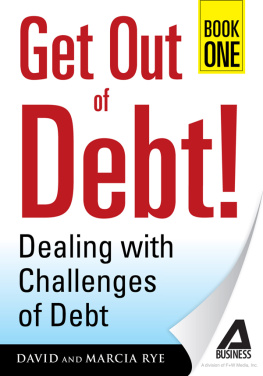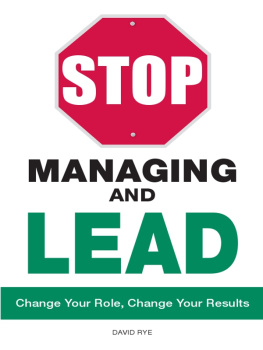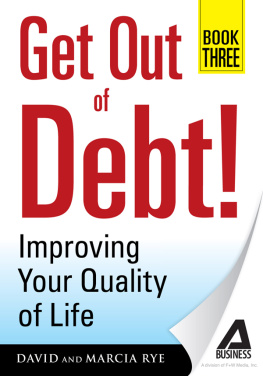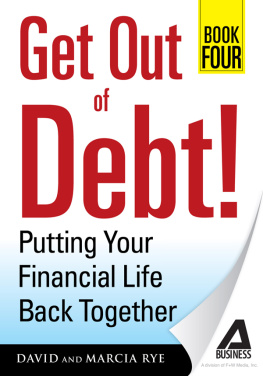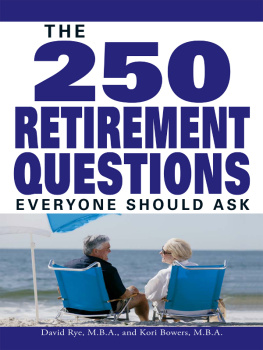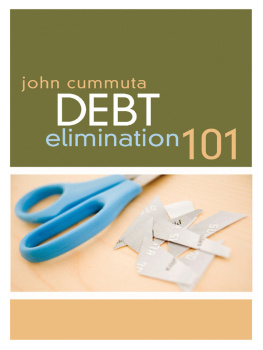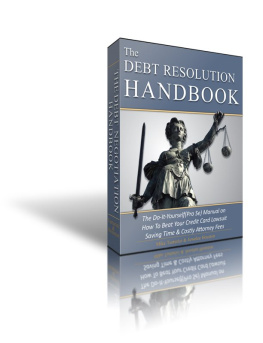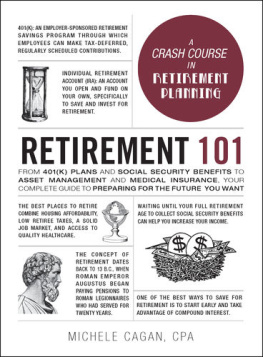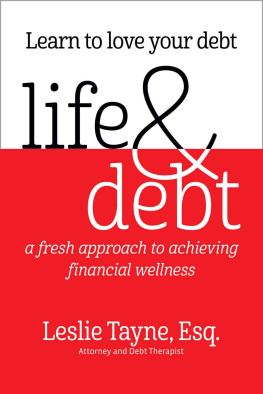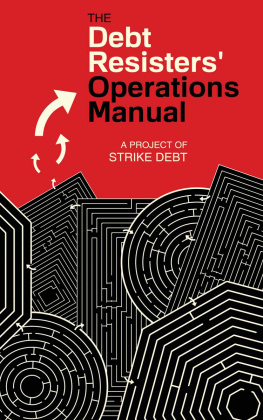Get Out of Debt!
Book One: Dealing with Challenges of Debt
DAVID AND MARCIA RYE
A division of F+W Media, Inc.
INTRODUCTION
Do you ever wake up at night worried about the financial setbacks and conflicts that youre having with your creditors? Do you become aggravated over the fact that you never seem to have enough money to live on? What are you going to do to control the confrontations that erupt when you address the subject with family members? What steps can you take to eliminate the financial mess that you are in?
Unfortunately, tens of millions of Americans are in your shoes. Like you, they are headed for financial disaster if they dont figure out a way to get out of debt.
This first installment of Get Out of Debt! has been written to answer your questions. As you read the material in this book, you will quickly learn how to assess the magnitude of your debt problems so that you can determine where youve been, how you got there, and, more important, where you want to go. When you plunge into these questions about how to avoid debt traps and how to create a realistic spending plan that works for you, you will discover the answers youve been looking for. Youll find out how you can dramatically improve the overall quality of your life once you eliminate your debt load.
The Get Out of Debt! series contains all of the elements you need to consider to get out of debt and improve your financial well-being. Each installment includes a set of questions that builds on what you learned from the previous one. Based upon your own situation, select the installment and questions that cover the subjects that are most important to you. That will allow you to maneuver through your personal debt-related issues and make the right decisions to avoid economic catastrophe. All four installments of Get Out of Debt! are filled with real-world examples and supplemented with detailed heres why it works illustrations.
The sooner you start mounting an assault on your personal debt, the sooner you will see your debt numbers heading down rather than up. When that happens, you will feel great!
Chapter
DEALING WITH
YOUR DEBT
The average debt level of people just like you is a scary 20 percent of their disposable income, not counting their mortgage debt. The average American owes $9,000 on his credit cards alone and hes lucky if he is just able to stay ahead of the bills. Only 1 percent of Americans are able to put some money away for savings. On top of all that, every American (man, woman, and child) owes $80,000 to Uncle Sam to pay off our insidious national debt. Over the past five years, the average total household debt (mortgages included) has soared from 60 percent to 75 percent of annual disposable income. These are just a few of the debt numbers that can make anyone become discouraged. Rather than dwell on them, lets get an overview of your situation.
#1. What is the primary cause of personal debt?
Excessive spending is the primary cause. It has become as addictive as alcohol or drugs in this country. Like alcohol or drugs, debts can interfere with every aspect of your life including damaging relationships with those who mean the most to you. Americans owe more money now than ever before. As you read through this chapter and assess your current debt situation, take an honest look at your spending habits. Do you have a spending plan thats written down and that you follow? How much are you spending every month by expense categories? Before you can solve any of your debt problems, you need to understand how you got into trouble in the first place. If you dont take the time to determine how you got into debt, then in all probability, you will repeat the same mistake again and again.
Think back to the point in time when you were able to live on your salary without having to borrow extra money. What happened that sparked your debt problem? Maybe you lost your job? Was it when you bought that fantastic car that you couldnt afford? When the issuer doubled the credit limit on your credit card, did you go on a spending spree? Maybe your debt problem was caused by a combination of things.
#2. Exactly what is personal debt and how does itaffect my credit?
Debt is the amount of money you owe someone, to be paid off usually with interest within a specific time period. Its money that you have already spent, to be paid back with dollars that you will earn in the future. Credit is the opposite of debt. It represents the potential to borrow money to buy something. When you use credit, you create debt and when you pay off debt, you create credit. Maintaining a healthy balance between the use of debt and credit is a critical component of a sound money management plan.
Credit is generally thought of as a good thing and most debt is considered a bad thing. Some people get confused about this relationship. Theyll acquire all the credit cards they can so that they can display them to their friends and brag about how much credit they have. At the same time, they will run up excessive debt to impress lenders about their ability to repay loans. Needless to say, that is not the way to impress lenders.
#3. How do I determine if I have a serious debtproblem?
People with serious debt problems often panic and move too fast to solve a problem that has been with them for years. Theyll quickly pay off the wrong kinds of debt without assessing their entire financial situation. In most cases, short-term fixes wont make their debt problems disappear. To determine if you have a problem, check the following warning signs. If three or more signs apply, you may have a serious debt problem.
- Always juggling payments or stalling one creditor to pay another and consistently receiving past due notices on your bills.
- Failing to save a consistent amount of money each month. Youre unable to save at least 5 percent of your paycheck each payday.
- Charging more each month than you make in debt payments and having more than five credit cards.
- Taking longer and longer to pay off your debts and using credit card cash advances to make payments on other debt accounts.
- Always running out of money before payday and bouncing checks on a recurring basis.
- Not knowing how much money you owe and searching through your junk mail to find applications for new credit cards.
- Charging purchases like groceries that you used to pay for in cash.
- Paying the bare minimum allowed on your debts (e.g., credit cards) every month.
#4. What do people who get into debt have incommon?
People who get into excessive debt are all addicted to overspending. The inappropriate use of loans and credit cards is one of the primary reasons why people encounter major debt problems. When their wallet is nearly empty and their checkbook balance is low, they should know theyre nearing their spending limit. But if they can easily turn to their credit cards, they can go into an overspending mode without realizing it until the bills start coming in.
Good credit management requires planning and constant monitoring. Take a look at your current credit situation. Do you know how much you pay out each month on credit cards and loan obligations? Are your total debts in line with your disposable income, which is the dollars you have left after taxes have been deducted from your paycheck? (Less than 10 percent is recommended.) Do you have money in a savings account that you can use to cover financial emergencies such as a job loss or sudden medical bills?
If your credit picture isnt clear in your mind, its time to organize your thoughts and take a closer look at where youre going financially. Overspending and living beyond ones means combined with a lack of awareness, self-control, and commitment will create excessive debt at an alarming pace. You can access a debt calculator at

